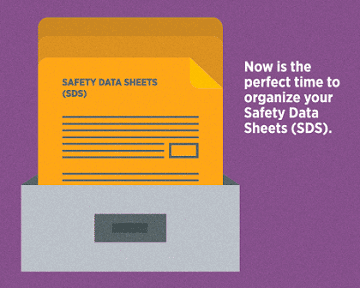- Home
- Loss Control
- Loss Control Insights
- Five Steps for Making the Most of Safety Data Sheets
Your most powerful resource in dealing with hazardous chemicals is the knowledge provided by safety data sheets (SDS). But to be effective, SDS must be kept up to date and easily accessible.
The federal Hazard Communication Standard requires chemical manufacturers, distributors and importers to provide SDS to organizations using their chemicals. If you have not done so already, now is the perfect time to organize your SDS and put that knowledge to use on a daily basis.
Step 1: Take an inventory of chemicals—Walk through your facility and make a list of chemicals that are used on a frequent basis. Start with non-consumer products. Consumer products such as household cleaners and hand sanitizer should be included in the list if they are used in an off-label manner and/or stored in large quantities.
Step 2: Secure SDS—Check your current collection of SDS. Make certain they are in the newest format that is easier to understand and provides more details. If a supplier has not sent you an updated SDS for a product, request it immediately. You can also search online for any missing SDS.
Step 3: Train employees—Make certain your employees know where to locate the SDS binder in the case of an emergency and are trained to understand the pictograms and hazard statements included in the new format. Remind them to review the labels on chemical containers before and after use. Many policyholders keep the SDS binder in a visible place in a breakroom and/or make the SDS available on their organization's intranet.
Step 4: Update your binder as needed—As you introduce new chemicals into your workplace, be certain you have a current SDS sheet or can obtain one online to add to your binder prior to using that chemical. Make sure to add that item to your inventory as well.
Step 5: Repeat annually—The chemical needs of your company may change year-to-year, so it is best to update your inventory and SDS binder on an annual basis.
About the SDS
SDS make it easier to respond to emergencies by providing vital information in the following sections:- Identification—Identifies the chemical and/or product on the SDS as well as the recommended uses. It also provides the essential contact information of the supplier.
- Hazard(s) identification—Includes the hazards of the chemical and the appropriate warning information associated with those hazards.
- Composition/information on ingredients—Identifies the hazardous ingredient(s) contained in the product, including impurities and stabilizing additives. This section includes information on substances, mixtures and all chemicals where a trade secret is claimed.
- First-aid measures—Describes the initial care that should be given by untrained responders to an individual who has been exposed to the chemical.
- Fire-fighting measures—Lists recommendations for fighting a fire caused by the chemical, including suitable extinguishing techniques, equipment and chemical hazards from fire.
- Accidental release measures—Provides recommendations on the appropriate response to spills, leaks or releases, including containment and cleanup practices to prevent or minimize exposure to people, properties or the environment.
- Handling and storage—Provides guidance on the safe handling practices and conditions for safe storage of chemicals, including incompatibilities.
- Exposure controls/personal protection—Indicates the exposure limits, engineering controls and personal protective equipment measures that can be used to minimize worker exposure.
- Physical and chemical properties—Identifies physical and chemical properties associated with the substance or mixture.
- Stability and reactivity—Describes the reactivity hazards of the chemical and the chemical stability information. This section is broken into three parts: reactivity, chemical stability and other.
- Toxicological information—Identifies toxicological and health effects information or indicates that such data are not available. This includes routes of exposure, related symptoms, acute and chronic effects and numerical measures of toxicity.
- Ecological information—Provides information to evaluate the environmental impact of the chemical(s) if it were released to the environment.
- Disposal considerations—Provides guidance on proper disposal practices, recycling or reclamation of the chemical(s) or its container, and safe handling practices. To minimize exposure, this section should also refer the reader to Section 8 (Exposure Controls/Personal Protection) of the SDS.
- Transport information—Includes guidance on classification information for shipping and transporting of hazardous chemical(s) by road, air, rail or sea.
- Regulatory information—Identifies the safety, health and environmental regulations specific for the product that is not indicated anywhere else on the SDS.
- Other information—Indicates when the SDS was prepared or when the last known revision was made. The SDS may also state where the changes have been made to the previous version. You may wish to contact the supplier for an explanation of the changes. Other useful information may also be included here.
Need More Assistance With SDS?
Your EMC risk improvement representative is ready to help you with SDS training and/or to answer questions about specific chemicals in your workplace.
A brief about the Hazard Communication Standard: Safety Data Sheets is available from the Occupational Safety and Health Administration (OSHA).
Get in touch
Need help? We’re here for you! Whether you have questions or need personalized assistance, your local office is ready to support you.
Loss Control Insights
Stay informed with the latest news and receive actionable safety tips, all carefully curated by our team of experts.
